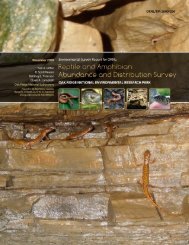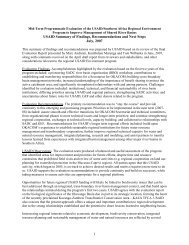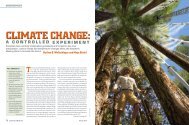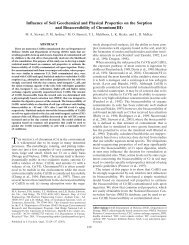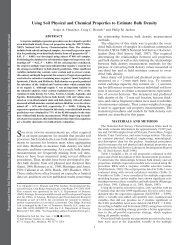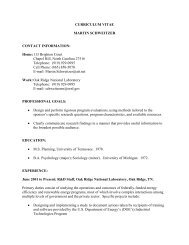oak ridge reservation physical characteristics and natural resources
oak ridge reservation physical characteristics and natural resources
oak ridge reservation physical characteristics and natural resources
Create successful ePaper yourself
Turn your PDF publications into a flip-book with our unique Google optimized e-Paper software.
1. OAK RIDGE RESERVATION PHYSICAL CHARACTERISTICS<br />
AND NATURAL RESOURCES<br />
The topography, geology, hydrology, vegetation, <strong>and</strong> wildlife of the Oak Ridge Reservation<br />
(ORR) provide a complex <strong>and</strong> intricate array of <strong>resources</strong> that directly impact l<strong>and</strong> stewardship <strong>and</strong><br />
use decisions (Fig. 1). The purpose of this document is to consolidate general information regarding<br />
the <strong>natural</strong> <strong>resources</strong> <strong>and</strong> <strong>physical</strong> <strong>characteristics</strong> of the ORR.<br />
The ORR, encompassing 33,114 acres (13,401 ha) of federally owned l<strong>and</strong> <strong>and</strong> three Department<br />
of Energy (DOE) installations, is located in Roane <strong>and</strong> Anderson Counties in east Tennessee, mostly<br />
within the corporate limits of the city of Oak Ridge <strong>and</strong> southwest of the population center of Oak<br />
Ridge.<br />
The ORR is bordered on the north <strong>and</strong> east by the population center of the city of Oak Ridge <strong>and</strong><br />
on the south <strong>and</strong> west by the Clinch River/Melton Hill Lake impoundment.<br />
All areas of the ORR are relatively pristine when compared with the surrounding region, especially<br />
in the Valley <strong>and</strong> Ridge Physiographic Province (Fig. 2). From the air, the ORR is clearly a<br />
large <strong>and</strong> nearly continuous isl<strong>and</strong> of forest within a l<strong>and</strong>scape that is fragmented by urban development<br />
<strong>and</strong> agriculture. Satellite imagery from 2006 was used to develop a l<strong>and</strong>-use/l<strong>and</strong>-cover cover<br />
map of the ORR <strong>and</strong> surrounding l<strong>and</strong>s (Fig. 3).<br />
Following the acquisition of the l<strong>and</strong> comprising the ORR in the early 1940s, much of the<br />
Reservation served as a buffer for the three primary facilities: the X-10 nuclear research facility (now<br />
known as the Oak Ridge National Laboratory [ORNL]), the first uranium enrichment facility or Y-12<br />
(now known as the Y-12 National Security Complex [Y-12 Complex]), <strong>and</strong> a gaseous diffusion<br />
enrichment facility (now known as the East Tennessee Technology Park [ETTP]). Over the past<br />
60 years, this relatively undisturbed area has evolved into a rich <strong>and</strong> diverse eastern deciduous forest<br />
ecosystem of streams <strong>and</strong> reservoirs, hardwood forests, <strong>and</strong> extensive upl<strong>and</strong> mixed forests.<br />
The combination of a large l<strong>and</strong> area with complex <strong>physical</strong> <strong>characteristics</strong> <strong>and</strong> diverse <strong>natural</strong><br />
<strong>resources</strong> has provided a critical foundation for supporting DOE’s environmental research mission, as<br />
well as the area in which to build leading-edge facilities.<br />
2. CLIMATE<br />
The climate of the Oak Ridge region may be broadly classified as humid subtropical. The term<br />
humid indicates that the region receives a surplus of precipitation compared to the level of evapotranspiration<br />
that is normally experienced throughout the year. The subtropical nature of the local climate<br />
indicates that the region experiences warm to hot summers <strong>and</strong> cool to cold winters. Such areas typically<br />
experience significant changes in temperatures between summer <strong>and</strong> winter.<br />
Local winters are characterized by synoptic weather systems that often produce significant precipitation<br />
events every 3 to 5 days. Although infrequent, these wet periods may be followed by arctic<br />
air outbreaks. While snow <strong>and</strong> ice are not usually associated with these systems, there is occasional<br />
snowfall each winter. Winter cloud cover tends to be enhanced by the region’s terrain.<br />
Severe thunderstorms are most frequent during spring, although the Cumberl<strong>and</strong> Mountains <strong>and</strong><br />
the Cumberl<strong>and</strong> Plateau (Fig. 3) usually inhibit the intensity of severe systems that traverse the<br />
region. Summers are characterized by warm, humid conditions. Occasional frontal systems can<br />
produce organized lines of thunderstorms (<strong>and</strong> rare damaging tornados). More frequently, however,<br />
summer precipitation is due to air-mass thundershowers that result from daytime heating <strong>and</strong> rising<br />
humid air. Although ample precipitation usually occurs during the fall, October tends to be the driest<br />
month of the year. The occurrence of precipitation during the fall tends to be less cyclic than during<br />
other seasons, although it is occasionally enhanced by decaying tropical systems moving north from<br />
the Gulf of Mexico. During November, winter-type cyclones again begin to dominate the weather.<br />
The terrain often exhibits a significant influence on local climate. Primarily, these effects result in<br />
1




